
Photo by Ashley Batz on Unsplash
Like personas, user journeys are a communication tool used to help organisations understand their users and how they interact with a product. Unlike static personas, user journeys describe the process users go through before, during and after their interaction with a product. Usually, this involves a basic timeline describing the steps in the process a specific type of user would go through and then goes on to describe their experiences, pain points and needs at each stage.
Visualising how the user interacts with a product as a journey is a great way to get a complete picture of the different steps a user has to take as well as their changing emotions, knowledge, wants and needs.
How to create a user journey
For a user journey to be useful, accurate and effective, it needs to be based on research and evidence. It is possible to create a fictional or idealised user journey based on how the designer/developer of the product believes a user will interact with it. However, the chance that this journey will be accurate is very low - without research, it's very hard to visualise every aspect of how a real user interacts with a product. Fictionalised journeys can, however, be used to identify gaps in what is known about the product, so that research can be designed to fill those gaps.
For an existing product, the best way to gather evidence on the user journey is to observe users engaging with the product 'in the wild,' i.e. one of the typical settings in which a product is used. Observation allows you to get an accurate understanding of how users complete tasks, including the mistakes they make, the workarounds they use and points at which they get confused or frustrated. It also allows you to identify the environmental constraints that impact how the product is used, such as interruptions. Detailed qualitative data gives a rich, realistic picture of how users genuinely engage with the product. This sort of research often reveals 'quick wins' - simple changes that can be made to the user journey that make it easier and more effective for the user, as well as more fundamental changes that need to be made to meet user needs.
For products that are still at the idea/design stage, a user journey is vital for ensuring that the design meets users' needs at every point of their interaction with the product.
The first step in creating a user journey for a new product is to set out as clear an understanding as possible of the problem the product is solving for the user.
- What tasks is the user trying to complete?
- What does the user need in order to complete those tasks?
To create as accurate a user journey as possible, it's important to also get a detailed understanding of your user, by carrying out carefully designed research with them that gives you rich evidence of their needs and attitudes.
One of the most effective ways to gather evidence is to look at how users currently solve the problem - what processes do they use? How effective are those processes? If you know what their current journey looks like you can identify ways that your product can/should improve the journey in order to successfully compete with existing solutions (even if those solutions are very basic ones, like spreadsheets or pen and paper).
Key advantages:
- Captures a lot of information about the process and experiences people go through when using a project or service
- Displays research findings in a graphic easy to understand format
- Highlights gaps in knowledge/understanding
Key disadvantages:
- Can be misleading if based on assumptions rather than evidence
- Captures one specific journey. So complex products can require lots of different journeys, diluting their value and potentially causing confusion
- Tends to generalise experiences, so can miss the nuance of an individual interaction



